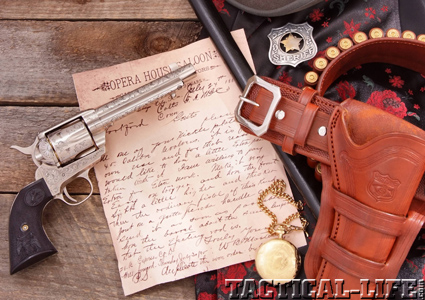Bat Masterson was back living in Dodge City in 1885 though his role as a lawman was “occasional” being deputized at the needs of the city or county Sheriffs. On July 24, 1885 Bat placed an order with Colt’s for two revolvers which, according to factory records, were completed for shipping on July 30, 1885.
By the time Bat Masterson received this handsome, nickel-plated six-shooter from Colt’s he was already a legend, as famous as his friends Wyatt Earp, Charlie Bassett, and Bill Tilghman. While most only knew Masterson by his reputation as a Dodge City lawman, or a high-toned dressing gambler, old friends like Earp and Tilghman, who had known Bartholomew Masterson in his youth, remembered him as a roughneck, buckskin clad buffalo hunter, skinner, and Cavalry scout, long before his days as sheriff in the Queen of Cowtowns, and fully a decade before he wrote the letter to Colt’s in July 1885 placing an order for the seventh of eight single-action revolvers he would own.
Born in Quebec, Canada, in 1853, the Masterson family had moved to Kansas by the time of the Civil War. Both Bat and his older brother Ed would eventually end up in Dodge City as lawmen, but long before Dodge they had made a name for themselves as buffalo hunters, Bat in particular distinguishing himself as a marksman with the Sharps rifle while defending the little hunting settlement of Adobe Walls in 1874 against a combined Comanche and Cheyenne raiding party led by the infamous Quanah Parker. After a five-day siege, Bat and 27 other hunters prevailed and the Indians withdrew. Adobe Walls, an old trading post on the Texas Panhandle, was already famous for a decade-old battle during the Civil War where Col. Kit Carson and the men of his expeditionary force had thwarted a Comanche raid on U.S. Cavalry forces sent west to protect settlers on the frontier. Masterson’s Adobe Walls settlement was only about a mile and a half from the site where Carson had been victorious in 1864.
Advertisement — Continue Reading Below
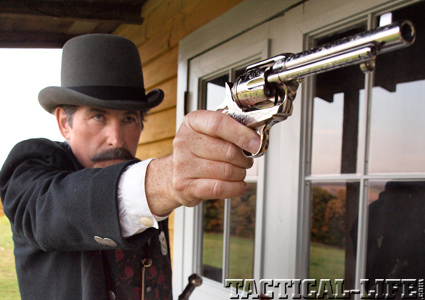
On June 29, 1885 Bat was wearing a Deputy Sheriff’s badge having been asked by Dodge City Sheriff Pat Sughrue to personally handle a touchy situation with a prohibitionist sure to be hung by an angry mob. Bat stood in the doorway of the hotel and ordered the crowd to disperse. It is unlikely anyone, outside of Wyatt Earp, could have single-handedly braced such a mob.
It was during the early 1870s that Bartholomew had decided to change his name to William Barclay Masterson. Most folks already knew him by then as Bart (short for Bartholomew), but he preferred Bat, and the nickname stuck. Still in their early 20s Bat and Ed Masterson befriended several other famous buffalo hunters who were also destined to make a name for themselves in Dodge City: Wyatt Earp, William Tilghman, and Neal Brown. Their lives would be intertwined for decades, particularly Bat’s and Wyatt’s.
The buffalo trade in the early 1870s eventually took the Masterson brothers to an emerging Kansas encampment named Buffalo City, where the Santa Fe railroad would soon pass through to take on shipments of buffalo hides being sent east. A.A. Robinson, the chief engineer of the Santa Fe railroad, had laid out the streets for the little Hell On Wheels Kansas tent city in the summer of 1871 and renamed it Dodge City. It became a hub for buffalo hunters in the spring and in winter a safe haven from the rugged plains. It was here that Bat learned another trade, gambling, and in this too, he excelled.
Advertisement — Continue Reading Below
Bat had proven himself with both the Sharps rifle and the Colt revolver by the early 1870s and his experience as a buffalo hunter and Indian fighter had made him an ideal choice as a U.S. Cavalry Scout. In 1874 he was hired by Col. Nelson A. Miles.[1] Masterson scouted for the cavalry until the spring of 1875, when he returned briefly to buffalo hunting. A year later he was involved in his first shootout in Sweetwater, Texas, with a cavalry sergeant named Melvin A. King. The fight was over a woman named Mollie Brennan and as Wyatt Earp wrote of the event, King walked into the Lady Gay saloon and opened fire on Masterson and Brennan, killing her and hitting Bat in the hip. Masterson managed to get his gun into action and cut King down with a clean shot to the heart.
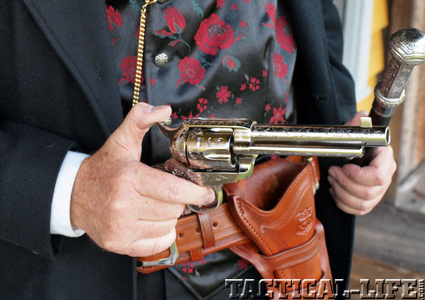
In town, where most everything happened at close range, Bat wore his Colt crossdraw style, butt forward and covered, making it almost impossible for anyone to disarm him from behind. He had seen many lawmen gunned down, some with their own guns taken from behind and turned on them. Note the special wide, raised front sight ordered by Masterson from Colt’s.
There are several versions of how the shootout unfolded, some with King ambushing Masterson and Brennan, other as a standup gun fight in the Lady Gay, but they all end the same, with Mollie Brennan killed, Bat severely wounded and King dead. The injury left Masterson with a permanent limp and thus the need for what would become his famous cane.
Advertisement — Continue Reading Below
Return to Dodge City
In his absence Dodge City (now part of Ford County, Kansas) had grown from a rough-hewn buffalo camp into a bustling cow town. When Bat returned in the late spring of 1876 he found an unruly city with little law enforcement, a town that the Hays City Sentinel had christened “the Deadwood of Kansas….Her corporate limits are the rendezvous of all the unemployed scally-wagism in seven states. Her principal is polygamy, her code of honor is the morals of thieves, and decency she knows not…” The Kinsley Graphic newspaper was somewhat less kind, naming Dodge the “…the Beautiful, Bibulous Babylon of the frontier.” And it was in Dodge City where Earp, Charlie Bassett, and the Masterson brothers would earn their early reputations as lawmen settling this unsettled burg.
It has been written that Bat first served as a Dodge City policeman in 1876 under Wyatt Earp, but if so it was short-lived because Masterson spent most of the early part of the year in Cheyenne, Wyoming, where it is possible he purchased the J.C. Collins gunbelt and holster that was one of several rigs he wore as a lawman. Bat’s interest in Cheyenne, however, was strictly the gaming tables where he made a haul before heading back to Dodge. En route he ran into Wyatt and Morgan Earp in Sidney, Nebraska. They had pulled up stakes in Dodge and Wyatt suggested that if Bat was going back he should run for county sheriff, but no sooner had he arrived than Bill Tilghman and Neal Brown asked Bat if he wanted to take one more run at buffalo hunting. He agreed to team up with them taking his trusty Sharps out of retirement and strapping on his latest Colt six-shooter.
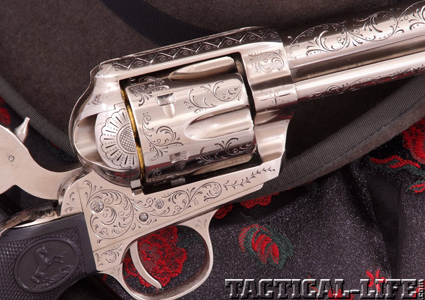
The engraving on the F.lli Pietta Bat Masterson single action is based on the pattern found on the seventh of Masterson’s Colt revolvers. This pattern is not a Colt factory design and was likely done by an engraver in Dodge City.
Advertisement — Continue Reading Below
It was during this hunt that Masterson demonstrated his skills with both a revolver and a rifle to the delight of Tilghman, who was no slouch with a six-gun himself. “I’ve seen Bat shoot at a tin cup thrown in the air, with his six-shooter, at twenty-five cents a shot, and make money at it.” As much as he enjoyed trick shooting Bat took the skills of the shootist seriously and noted in one of his 1907 magazine articles that, “…looking through the sights is a very essential thing to do when shooting at an adversary who is returning your fire.” Masterson’s belief in using the gun’s sights and not shooting from the hip, as he was so often reported to have done, is supported by the first of many written orders for guns sent to Colt’s. In 1879 he requested a custom-tailored, personally inscribed single action, further noting that it be silver plated with Mexican eagles carved in pearl handles and have a front sight slightly higher than normal, his personal preference.
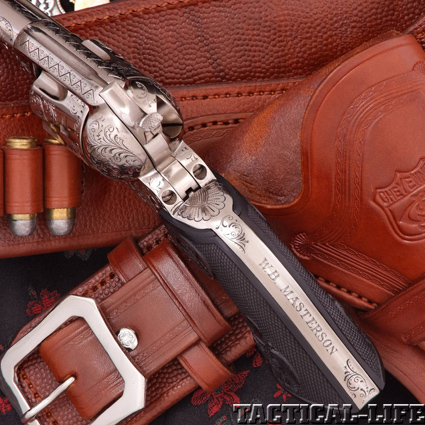
The inscription on the backstrap was typical of guns ordered by Masterson from Colt’s.
One of Eight
During the course of his career as a lawman and gambler, Bat ordered a total of eight single-action revolvers from Colt’s. The most notable was an order made from Dodge City and written on Opera House Saloon stationary in July 1885 which stated:
Advertisement — Continue Reading Below
Gents
Please send Me one of your nickel plated short .45 calibre revolvers. It is for my own use and for that reason I would like to have a little Extra pains taken with it. I am willing to pay Extra for Extra work. Make it very Easy on the trigger and have the front Sight a little higher and thicker than the ordinary pistol of this Kind. Put on a gutta percha handle and send it as soon as possible, have the barrel about the same length that the ejector rod is.
Truly Yours
W B Masterson
P.S. Duplicate the above order by sending 2
By then Bat had already served as Under Sheriff of Ford County for Charlie Bassett, replacing him in 1877 after Bassett had served two consecutive terms (under Kansas law a Country Sheriff could not hold office for three consecutive terms). His first act after becoming County Sheriff, not surprisingly, was to appoint Charlie Bassett as Under Sheriff, the two essentially exchanging badges. During his tenure in Dodge City, which was also the County Seat and home to the Ford County Sheriff’s office, Bat appointed many of his old associates as special deputies when situations became thorny. Ford County encompassed some 9,500 square miles, a large portion of southwestern Kansas — a lot of territory into which outlaws could quickly vanish. In their pursuit Bat called upon Wyatt Earp, as well as appointing his younger brother James Masterson and friend Bill Tilghman Deputy Sheriffs. Dodge City also had its own City Marshal, Ed Masterson, and a local police force. Dodge was a tough town and it needed every lawman it had.
Advertisement — Continue Reading Below
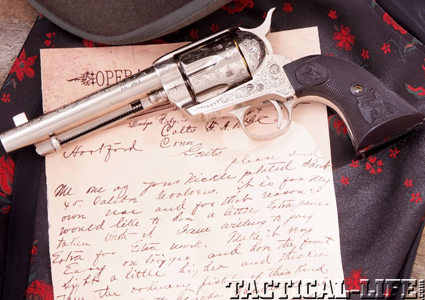
This is a copy of the letter written by Bat Masterson to Colt on July 24, 1885 ordering two nickel plated single actions with light triggers and higher, thicker front sights, shorter barrels and gutta percha grips.
As County Sheriff, Bat’s rule of thumb was to buffalo an armed man first and then ask questions later, a technique he had learned from Wyatt in which the barrel of a six-shooter is firmly applied to the head of miscreants. It was a controversial practice but Wyatt and Bat always defended it use. And it was clearly posted on the way into Dodge that no guns were to be worn within the city limits. Often ignored by cattlemen, a great part of every law officer’s duty was to enforce the rule. And at times, with a bunch of liquored up cowboys running rampant, it could be a deadly job. In April of 1878 Ed Masterson was shot at point blank range doing just that, disarming a drunken cowboy who had openly ignored the rules. Ed returned fire and downed two men before he stumbled across the street and collapsed. He died 40 minutes later. Bat’s friend, Deputy Sheriff Charlie Bassett took over as City Marshal and Wyatt assumed the position of Deputy Marshal the following month. Bat had not been in Dodge the night Ed was murdered.
His brother’s death hit Bat hard because he always had believed Ed was too easygoing and not as deliberate as he should have been. Bat had seen many lawmen gunned down, some with their own guns taken from behind and turned on them. He wore his Colt crossdraw style, butt forward and covered, making it almost impossible for anyone to disarm him from behind. It has also been written that he carried two guns, and in some instances he did when heading up a posse or on the open plains, but in town where most everything happened at close range, it was the short barreled Colt carried cross draw that Bat preferred over any other.
Advertisement — Continue Reading Below
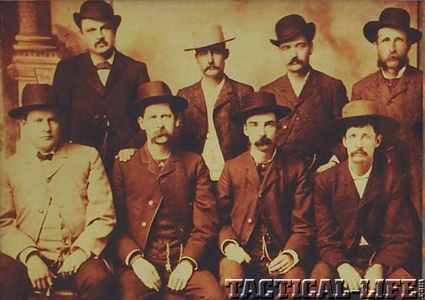
Wyatt Earp, seated second from the left, and Bat Masterson, back row third from the left, in a photo taken around June 10, 1883 after Masterson, Earp, Charlie Bassett (front row far left) and Neal Brown (front row far right) returned to the city to restore their friend Luke Short (standing second from left) to his position as owner of the Long Branch Saloon. Dodge City politics were unraveling in June and the visit from the famous former lawmen soon restored a sense of order to the cow town. Also pictured are W.F. Petillon (back row at far right) and W.H. Harris, (back row far left). The photo came to be known euphemistically as the Dodge City Peace Commission.
In 1879 Masterson began his last office as a lawman in Kansas being appointed a U.S. Deputy Marshal. Ironically, though he had faced down countless cowboys on rampages through Dodge, and pursued murders, bank robbers, cattle rustlers and thieves, in his entire career as a lawman, Bat never killed anyone he apprehended. Many were wounded, but none were shot dead. His reputation for having killed 27 men as a peace officer was all legend, and Bat was wise enough to let the tales stand, as fear of his gun was as effective a weapon as the gun itself. Bat only killed one man in a shootout, his first and only, Melvin A. King.
Moving On
Advertisement — Continue Reading Below
By 1880 Wyatt Earp had resigned as Assistant City Marshal of Dodge City and started out for Tombstone with brothers Virgil and Morgan. Bat’s tenure as County Sheriff had also come to an end with his defeat in the next election. Over the next few years Masterson was continually drawn between Kansas and Colorado, where he served as City Marshal of Trinidad, Colorado in 1882, but he eventually gravitated back to Dodge to work the gambling tables. He also developed an interest in officiating boxing matches, another trait that he had picked up from Wyatt that oddly enough was to take his life in an entirely new direction by the turn of the century. And, there was one more facet to W. B. Masterson that emerged to everyone’s surprise, especially his often vocal critics in the press, he liked writing; writing letters to editors, political editorials, and sports commentary. Between writing, gambling, and occasionally serving in his capacity as a U.S. Deputy Marshal, by 1885 when Masterson ordered the seventh of his single-actions from the Colt factory he had become a frontier legend, and he was only 32 years old.
Throughout the latter part of the 1880s Bat was in and out of Dodge, and on occasion, such as in June of 1885, was requested to fill in as a Deputy Sheriff to help “resolve” differences where his reputation and the inscribed Colt Peacemaker in his holster were generally enough incentive to the wise. This proved sufficient to ward off a mob bent on lynching prohibitionist Albert Griffin who was on a crusade to shut down Dodge’s saloons. Masterson stood in the doorway of the temperance man’s room, his hand resting on the butt of his Colt and ordered the crowd to disperse. Despite their vocal protestations the angry mob began to break up. Although not a fan of Masterson, Griffin later acknowledged that Bat had saved his bacon that day.
In 1888 Bat finally bid farewell to Dodge City taking up residence in Denver, Colorado, where his major income was derived from gentleman’s gambling, fight promoting, and as an official referee for the new Colorado Athletic Association. An 1894 issue of Illustrated Sporting West called Bat Masterson “…one of the best judges of pugilists in America.”
The unsettled west that Bat and Ed Masterson had ventured into in the 1870s as young men was all but gone by the turn of the century, as was Bat’s enthusiasm for the life. In the summer of 1902 be boarded a train in Denver bound for New York City and began a career as a sports writer, journalist and author, penning the series of articles in 1907 about his life that would become the foundation for his book Famous Gunfighters of the Western Frontier.
Lawman and gunfighter William Barclay Masterson turned out to be one of the finest sports writers of the early 20th century, working as a journalist and sports editor at the Morning Telegraph up until his death, still at his desk the morning of October 25, 1921 when his heart gave out and he passed into the pages of immortality at age 67.
There is an old adage that “there are bold gunfighters and there are old gunfighters, but that there are no old, bold gunfighters.” Bat Masterson was one of the few exceptions. Long after Dodge City was behind him Bat kept the legend alive, not as a gunfighter or lawman but as a journalist; proof perhaps, that the pen is indeed mightier than the sword, or the gun!
Interested in reading more? Try our articles about Great Old West Guns: Part 1 and Part 2!
